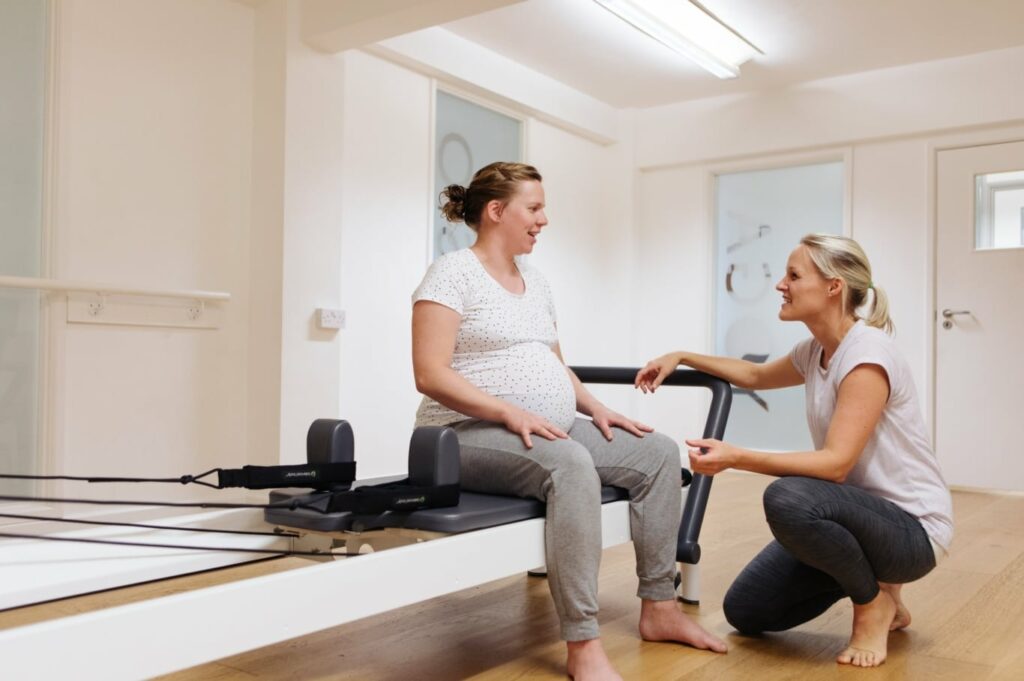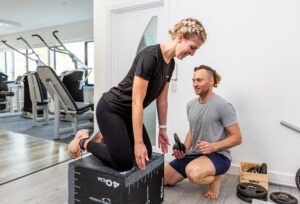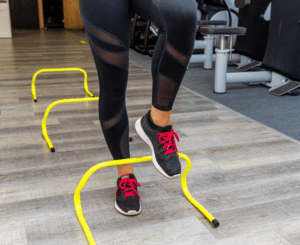Introduction:
Pregnancy is a beautiful but sometimes challenging journey. The third trimester brings you one step closer to meeting your little one. It’s also a time when your body goes through significant changes. Staying active during this phase can help alleviate discomfort, boost your energy, and prepare your body for labour. In this blog post, we’ll provide guidance on safe and effective exercises for women in this final stage of pregnancy. Before starting or continuing any exercise routine during pregnancy, it’s crucial to consult with your healthcare provider. They can assess your individual health and provide personalised recommendations based on your specific needs and circumstances.
Based on the current research the following exercises can be beneficial for women in their third trimester of pregnancy:
- Low-Impact Cardiovascular Exercises:
Engaging in low-impact cardiovascular exercises can help maintain your cardiovascular fitness and keep your energy levels up. Great options for the third trimester include:
Walking: A brisk walk can be gentle on your joints while providing a good cardiovascular workout.
Swimming: The buoyancy of water reduces the impact on your joints, making it a fantastic full-body workout.
Stationary cycling: Riding a stationary bike is low-impact and allows you to control the intensity.
Prenatal Yoga or Pilates: Prenatal yoga or pilates is an excellent choice during the third trimester. It helps improve flexibility, balance, and relaxation. Stretching can help alleviate tension and discomfort, especially in the later stages of pregnancy. Consider incorporating gentle stretching exercises into your daily routine. You might also benefit from relaxation techniques such as deep breathing and meditation to reduce stress and anxiety. Practicing deep breathing exercises and relaxation techniques can help reduce stress and anxiety during pregnancy. These techniques can be beneficial for both physical and mental well-being.
- Strength Training:
Maintaining muscle strength is essential during pregnancy, as it can help support your growing belly and prepare your body for labor. Focus on exercises that target major muscle groups, such as squats, lunges, and modified push-ups. Always use proper form and avoid lifting heavy weights.
- Pelvic Floor Exercises:
Pelvic floor exercises, also known as Kegel exercises, are vital during pregnancy. They help strengthen the muscles that support your pelvic organs, uterus, rectum and can improve bladder control. These exercises can be done discreetly throughout the day.
Here are some tips:
- Identify the Pelvic Floor Muscles: The first step is to locate the pelvic floor muscles. You can do this by stopping the flow of urine midstream. However, this is just for identification purposes; it’s not recommended to do Kegel exercises while urinating regularly.
- Find a Comfortable Position: You can perform Kegel exercises in various positions, such as sitting, standing, or lying down. Choose the position that’s most comfortable for you.
- Contract the Muscles: To exercise the pelvic floor muscles, contract them as if you’re trying to stop the flow of urine or hold in gas. Imagine lifting and squeezing the muscles inside your pelvic area. Be sure not to tense your abdomen, buttocks, or thighs while doing this.
- Hold the Contraction: Once you’ve squeezed the muscles, hold the contraction for a count of three to five seconds, or as long as you can comfortably manage.
- Release and Relax: After holding the contraction, slowly release and relax the pelvic floor muscles for an equal duration, typically three to five seconds.
- Repeat: Perform the contraction and relaxation sequence 10 to 15 times in a row. This constitutes one set. Aim to do at least three sets of Kegel exercises per day.
Tips for Effective Kegel Exercises:
- Breathe naturally while doing Kegel exercises; don’t hold your breath.
- Focus on isolating the pelvic floor muscles without contracting other nearby muscles.
- Gradually increase the duration of each hold and the number of repetitions as your pelvic floor muscles become stronger.
- Be consistent and perform Kegel exercises regularly for the best results.
It’s important to note that Kegel exercises are not a one-size-fits-all solution. If you have concerns about your pelvic floor health or experience urinary incontinence, consult with a pelvic health specialist. They can provide personalised guidance and recommendations for your specific needs and circumstances.
While it is great to try to stay fit and active it is important that you take care of yourself while you are undergoing such significant changes. Your body is under a lot of stress. The following points are essential tips to ensure you can stay safe and as comfortable as possible while staying active.
- Listen to Your Body:
As your body changes, it’s essential to listen to its signals. If you experience pain, dizziness, shortness of breath, or any unusual symptoms during exercise, stop immediately and consult your healthcare provider. It is also important you don’t be too hard on yourself. This final stage of pregnancy can be challenging. You may not feel able to be as active as you want to be and remember this is OKAY.
- Hydration and Rest:
Stay well-hydrated before, during and after exercise. Also, make sure to get adequate rest and listen to your body’s need for breaks and sleep.
- Supportive Gear:
Exercising may feel very uncomfortable. Wearing comfortable, supportive workout attire and appropriate footwear will help you. A maternity support belt can help reduce back discomfort during exercise.
- Stay Cool:
Exercise in a well-ventilated space and avoid overheating. Wear breathable clothing and drink water regularly.
- Healthy Balanced Diet
It is vital for you to fuel you and your baby with a healthy balanced diet. Proper nutrition is essential for a healthy pregnancy and will help you feel energised,
Conclusion:
Exercise can be a wonderful way to stay healthy and prepared during your third trimester. However, safety should always come first. Consult your healthcare provider, choose activities that make you feel good, and remember that it’s okay to modify or skip exercises as needed. The most important thing is to prioritise your well-being and the health of your baby. Enjoy this special time in your life and stay active for a happy, healthy pregnancy. The team at Tops:health are happy to help you in your significant journey, supporting you to ensure you feel like the best you.



